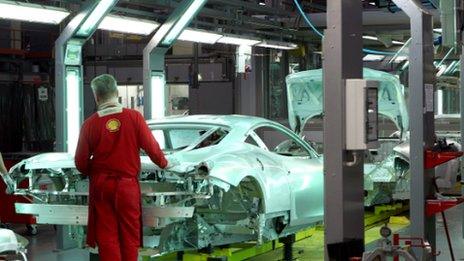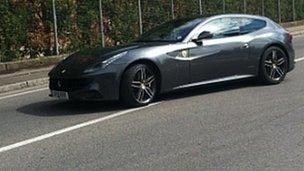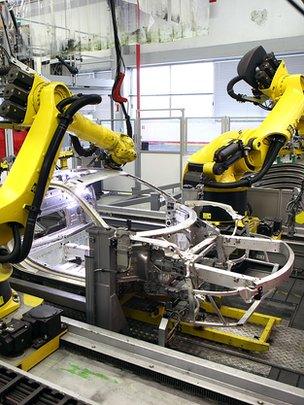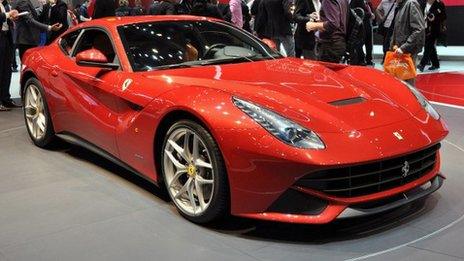Changing attitudes transform Ferrari
- Published
Jorn Madslien visits Maranello to see how the supercar giant cut its cars' emissions by 30%
Driven slowly through the winding streets of Fanano, the yellow Ferrari feels relaxed, its eight-cylinder engine quietly ticking over at low revs.
By Ferrari standards, the California is a gentle supercar. It is easy to live with, and unlike Ferraris of the past it seems to be well suited for daily commutes.
Also by Ferrari standards, the car might seem like a soft option that threatens the Prancing Horse's image as a carmaker for performance purists.
But a £150,000 car that accelerates from nought to 60mph (0-100km/h) in just 3.8 seconds still delivers on Italian mountain roads, where precise cornering and controlled braking help its 490 horses keep up a steady canter towards the Ferrari factory in Maranello.
Signs of expansion

Ferrari has changed the way it makes cars
The California is a potent symbol of how Ferrari has changed since BBC News last visited Maranello in 2007, external, and inside the factory gates there are further signs of how the supercar company has evolved.
Much remains the same, of course, as Ferrari remains a virtually autonomous carmaker, complete with its own wind tunnel and a foundry that casts engine cases and parts such as cylinder heads.
But there are also signs of dramatic expansion, with the old assembly line having been replaced by an ultra-modern two-storey affair that offers both greater capacity and efficiency.
The cramped engine manufacturing operation, which also makes engines for Maserati, is also about to be replaced by a more modern operation in a building currently under construction.
New customers

New models such as the Ferrari FF have attracted new customers to the brand
The developments seen on the ground reflect how attitudes have changed in Maranello.
Until about a decade ago, Ferrari was deliberately limiting the number of cars it made to 4,000 in order to ensure the marque's exclusive image.
These days, the talk is instead of "different Ferraris for different Ferraristas", a reflection of the way the carmaker's model range has been extended to drive dramatic growth in sales.
"Ferrari does not have only one type of customer," says chief executive Amedeo Felisa in an interview with BBC News, pointing to how the California and the four-seater, four-wheel-drive FF model have helped attract a lot of new buyers to the marque.
Bolstered by these models' popularity, Ferrari's sales surged to almost 7,200 cars in 2011, along with record profits.
And judging by its recent performance, with new output and profit records hit for the first half of 2012, along with the ongoing investment in the assembly and engine plants, it seems clear the carmaker expects the growth to continue.
Attention to pollution

Ferrari's new assembly line is highly automated
At a philosophical level, Ferrari's growth is backed by a more reflective and responsive approach to changing attitudes in society, in particular in relation environmental impact.
"In 2007, when Ferrari turned 60 years, the company's executives decided it was time to adjust to the way people's lives were changing," Mr Felisa says.
"Until then, we had dedicated our attention to performance," he says.
"We realised we'd have to add to that and direct some research and development attention in the direction of emissions."
Dramatic improvements
Ferrari's efforts to reduce average emissions were not merely motivated by altruistic desires, of course.
Emissions regulations are also getting stricter in many markets, with carmakers facing massive fines if they fail to comply.
But regardless of Ferrari's motivation, the result has been dramatic, according to figures from automotive industry analysts Jato Dynamics.
"Ferrari has already reduced its average emissions by more than 25% since 2007," observed Jato research executive Gareth Hession in March, referring to 2011 data.
Emissions and performance
Mr Felisa says further improvements should bring the figure to 30% by the end of 2012, and he is eager to point out this has been done without giving up on Ferrari's main competitive advantage.
"Reducing carbon dioxide emissions is easy if you reduce performance," he says.
"But this is not our field, so we've had to find areas where we can improve the efficiency of the cars."
Launching the California, which accounts for almost half of Ferrari's sales, has clearly helped. It emits just 301g/km, which is still about three times as high as the emissions from many mainstream family cars, though dramatic when compared with the 2007 average of 438g/km.
But improvements across the range have been delivered by more efficient engine and transmission systems, including in models targeted at traditional Ferrari customers.
Weight reduction, aided by the use of lightweight materials such as aluminium and carbon fibre, combined with improved aerodynamics, better braking systems and improved tyres, have also helped, Mr Felisa says.

Ferrari's F12berlinetta is faster and more powerful than its predecessor, yet it emits less carbon dioxide and uses less fuel
Hence, the V8-powered 458 Italia and 458 Spider models both represent dramatic efficiency improvements when compared with similar models from the past.
And the carmaker's latest V12-powered F12berlinetta supercar, which goes on sale this month, is not only 100kg lighter than its predecessor, the 599.
The F12 is also more powerful, with 730hp under the bonnet compared with the 599s 612hp, yet Ferrari says the F12 can deliver 18mpg (15.7l/100km) and carbon emissions of 350g/km - a 30% improvement over the 599.
Taxing ownership
Ferrari's latest models are warmly welcomed by buyers across the 60 countries where the carmaker is operating.
But at home in austerity-struck Italy, all is not well.
Here, Ferraris have become red flags for the authorities, who have started stopping them in the street, then ordering tax audits of their owners.
In response, Italy's wealthy have virtually stopped buying the cars and started shipping the ones they already own out of the country at a rate of knots, resulting in a near trebling of the exports of luxury cars during the first half of 2012.
Hence, at a time when Ferraris are becoming ever more commonplace around the world, in their homeland they are set to become increasingly rare.